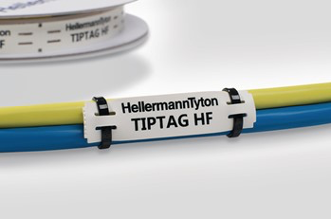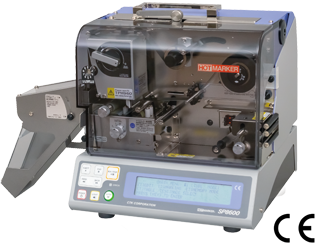The Hot Marker: SP8600 Is Ideal for Marking on Tiptag
This detailed article discusses the various printing methods for "Tiptag." It introduces the "Hotmarker: SP8600," an ideal tool for marking on identification tags used for wiring and piping, known as "Tiptag." The article also compares the features of thermal printers, inkjet printers, and laser markers, making it a must-read for those seeking durable and cost-effective options.
Tiptag is an identification and display tag used for labeling wiring, piping, and similar components. It displays information such as the destinations and contents of various wiring and piping and is widely utilized in industries like electronics and factory equipment.
This article explains the key features of Tiptag and introduces the most effective product for marking on display labels: the Hotmarker: SP8600.
Tiptag is a product by HellermannTyton Corporation that is designed to identify wiring and piping. It offers excellent flexibility and durability and can be easily attached using cable ties, making installation simple, even after wiring work is completed. The tags are sold in reel form and can be separated and used individually.
The content displayed on the tags can be printed using a specialized printer, producing labels with superior weather and heat resistance.
Three Features of Tiptag
This section explains the three key features of Tiptag as a display and identification tag.
Excellent Heat Resistance and Flame Retardancy
The material used for Tiptag is polyurethane, a flame-retardant resin graded "94V-0" under the UL94 standard. This allows it to operate in a temperature range of -65℃ to +120℃, making it suitable for use on piping that carries high-temperature fluids and around high-temperature equipment in factory facilities. Additionally, its self-extinguishing properties make it ideal for use in electronic devices with high safety requirements.
Weather and Environmental Resistance for Outdoor Use
Due to its polyurethane composition, Tiptag offers superior weather and chemical resistance. When used with weather-resistant cable ties, it can be installed outdoors or in environments exposed to chemicals without deteriorating, maintaining identification information for extended periods.
Flexibility and Mechanical Strength
Made from flexible and mechanically strong polyurethane, Tiptag can be attached to various locations, from thin wires to thick pipes, including curved or movable parts. Its flexibility improves workability, making installation easier and preventing the tag from shifting or detaching.
Uses and Benefits of Tiptag
Tiptag is primarily used to identify and display wiring and piping. It is used to indicate which terminal or valve the wiring or piping should connect to and to display the type of fluid flowing inside the pipes. Tiptag, which can be attached with cable ties even after wiring work, also allows for easy bundling of multiple wires.
Furthermore, the appropriate cable ties can be attached to larger diameter pipes, allowing for visual checks of the flow direction and pressure information of the fluid inside. This contributes to accident prevention and enhances the efficiency of maintenance work.
Hotmarker: Suitable for Marking on Tiptag
Our Hotmarker is ideal for marking on Tiptag. By using a dedicated jig (workpiece holding fixture), it allows easy marking, just like with marker tubes, marker labels, and marker plates for wiring.
The Hotmarker directly heats the marking foil and Tiptag to fix the ink, making it resistant to peeling, with excellent abrasion and weather resistance. Combined with the appropriate marking foil, it also offers high heat and chemical resistance.
Other marking methods include inkjet printers and laser markers, but due to issues with setup, marking performance, safety measures, and the high cost of equipment, HellermannTyton does not recommend them.
Tiptag is often used for wiring in electronic devices and piping in factory equipment, with applications ranging from indoor to outdoor environments. Therefore, high heat resistance, abrasion resistance, weather resistance, and chemical resistance are required. Additionally, since wiring work is often done on-site, thermal printers are suitable for Tiptag as they do not require the safety measures necessary for laser markers.
Selection of Hotmarker
There are two types of Hotmarker: thermal printing and hot stamping. For marking on Tiptag, the SP8600 is the most suitable option, as it supports sequential numbering and produces highly weather-resistant and heat-resistant Tiptag when used with the marking foil. Tiptag is our recommended tag for wiring and piping, and various evaluations, including print quality, have been conducted to ensure its safe use.
We strongly recommend using only genuine CTK products to ensure the best marking results. And the warranty may not cover issues arising from the use of non-genuine products.
Features of SP8600
The SP8600 is ideal not only for identification and display tags like Tiptag but also for marking on marker tubes for wiring and electrical wire coatings. It can accommodate pipe sizes with outer diameters ranging from 2.0 to 28.0 mm and marker tubes for wiring with flat widths of 3.2 to 45.0 mm. Additionally, it enables the production of marker tubes for wiring while cutting them.
With a marking speed of approximately 4,900 units per hour, the SP8600 offers a 10% improvement over the previous model, the SP6600 (when marking a 20 mm tube with five characters on one line).
The user interface supports standalone use of the SP8600 by connecting an optional keyboard, along with the included dedicated software, PCMS.
The types of characters it can print include English letters, and it supports sequential marking with automatic numbering in both 4-digit decimal and hexadecimal . Additionally, it can incorporate images and logos, offering enhanced customization options.
Basic Specifications of SP8600
The basic specifications of the SP8600 are as follows:
| Model | SP8600 |
|---|---|
| Marking Targets |
|
| Production Capacity | Tube Mode: Approximately 4,900 pieces/hour |
| Display | LCD screen with white backlight (40 characters × 4 lines) |
| Supported OS | Windows 10, Windows 11 |
| Interface | USB |
| Options | USB memory, others |
| Dimensions | 432(W) x 280(D) x 302(H) mm |
| Weight | 12.0 kg |
About Printing Methods
Hotmarker offers two printing methods: thermal printing and hot stamping. Below is a comparison of their features.
Features of Thermal Printing
Thermal printing uses heat generated at the tip of the print head for marking. The print head applies pressure to a film-like marking foil, and the heated area reacts, transferring the ink to the workpiecel, where it adheres. This method is suitable for marking on resin and plastic. Settings and adjustments for the print content can be made using a keyboard or PC software, making it simpler compared to the hot stamping method.
We offer the thermal printing Hotmarker ,SP8600 model. Please check the product page for further details.
Features of Hot Stamping
Hot stamping involves pressing type directly onto the workpiece. This method allows for embossing (imprinted marks) simultaneously with marking, resulting in highly visible prints. Suitable targets include molded plastic products, such as cable ties and connectors, as well as control cables and coated wires.
The advantage of hot stamping is its high design versatility, offering embossed patterns and a wide variety of colors. However, it also has significant limitations, such as material restrictions due to the pressing method and the need to replace the type when changing print content.
We offer a customizable hot stamping Hotmarker model, the B330P, which can be tailored to your specifications. Please check the product page for further details.
Contact Us!
Please visit the product page for detailed information about the SP8600 mentioned in this introduction.
If you have any inquiries regarding our other Hotmarker products that are suitable for marking on materials other than Tiptag, or if you have questions about installation, please contact us using the information below. Our specialized staff or the local distributor close to your location will provide the optimal solution based on extensive experience and knowledge, taking into account factors such as the material and shape of the workpiecet, the print content, and the production volume.
For inquiries regarding marking on identification and display tags other than Tiptag, please contact us separately.




